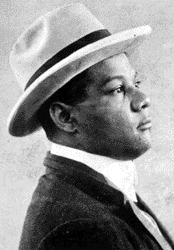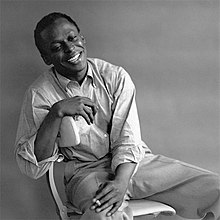Festival International 1949 de Jazz
The Festival International 1949 de Jazz was a jazz festival held in Paris' Salle Pleyel from May 8th to 15th .
Organizer Charles Delaunay also organized similar festivals in Paris in 1952 and 1954 (Festival International de Jazz), with the 1952 festival being completed by Jazz at the Philharmonic .
The festival from May 8th to 15th, 1949
At least since the arrival of Dizzy Gillespie in 1948, jazz had experienced a great boom in Paris; in the spring of 1949 Charles Delaunay , Franck Bauer , Eddie Barclay and his wife Nicole organized a “great week of jazz”. Eleven American musicians such as Kenny Clarke , Tadd Dameron , Miles Davis , Al Haig , James Moody , Charlie Parker and Max Roach were booked ; there were also European artists such as Toots Thielemans and Hazy Osterwald . The French jazz scene was u. a. represented by Aimé Barelli , Jack Diéval , Hubert Rostaing . The traditional jazz was by Sidney Bechet and Pete Johnson represented the (then) "mean wave of Jazz" (Vian) by Oran "Hot Lips" Page and "Big Chief" Russell Moore and the "new" movement in jazz by Charlie Parker Quintet and the Tadd Dameron / Miles Davis Quintet.
But in the end, Sidney Bechet, who lived in Paris, had the greatest success; With numbers like "High Society" he got the audience racing, according to Charlie Parker's biographer Ross Russell , while Parker's more intimate set was only recognized by avant-garde audiences like Boris Vian and Delaunay, but less so by the general public. Parker played the titles with which he had previously celebrated success at his Royal Roost concerts in 1948/49 , such as "Scrapple from the Apple", " Out of Nowhere ", "Barbados", " Salt Peanuts " and the " 52nd Street Theme" ". Charlie Parker performed with his band of Kenny Dorham, Tommy Potter , Al Haig and Max Roach on opening day, May 8th and Monday, May 9th; In addition, a jam session with Parker's Band, Miles Davis, Aimé Barelli, Hubert Rostaing, Bechet, Don Byas , James Moody, Toots Thielemans and Hazy Osterwald as vibraphonist took place at the final concert on May 15th . The whole thing was later called "Farewell Blues"; this is where bebop , tradition and mainstream meet. Wilson and Ulfert Goeman cite André Hodeir's opinion in their Parker biography that Bird's performance was "the main attraction of the festival, even if a large part of the audience did not understand his music".
The Tadd Dameron / Miles Davis Quintet performed on May 9, 10, 14 and 15. Boris Vian praised Dameron's “extremely finely developed harmonic imagination” in a contemporary review, “and his playing is wonderfully coordinated with that of Miles Davis”. Even then, Vian recognized his talents in the slow and medium-paced pieces: “He has an unadorned and sparse phrasing that is really adorable. He finishes the most unexpected phrases with a startling logic and informality. ”In his review, Vian also highlighted the use of James Moody and the rhythm section of Kenny Clarke and Barney players .
Hot Lips Page was accompanied by French musicians, Bernard Peiffer on piano, Roger Paraboschi on drums and Jean Bouchéty on bass; added trombonist "Big Chief" Russell Moore, tenorist Don Byas and alto George Johnson. Vian felt reminded of the "Jump" style of the 1930s when they played their music. Sidney Bechet was accompanied by Pierre Braslavsky's orchestra.
Effects of the festival
The success of the Paris festivals was an initial spark for the spread of bebop on the continent. The attention that the American musicians received in Paris “was far from what was true in America,” wrote Ross Russell, “the critics who reported on the festival for the Paris newspapers were the same, the important ones Matinees, symphony concerts and operas reviewed. New jazz records were presented with the same seriousness as new books. ”On the whole, black musicians in Europe were exposed to less discrimination than at home,“ and without question their music was much more adored and respected and had a cultural status ” wrote Mike Hennessey in his Kenny-Clarke biography. The resounding success of the Paris Festival contributed to the fact that a participating musician, Kenny Clarke, settled in Paris; Later Bud Powell , Woody Shaw , Dizzy Reece , Slide Hampton , Jimmy Woode , Johnny Griffin , Kenny Drew and Nathan Davis also came to the French capital. Miles Davis later commented on the special atmosphere in his memoirs:
“ It was a completely new feeling. The freedom to be in France and to be treated as a person. As an important person. Even our band's sound and music were better here. "
Recordings made in Paris in 1949 (selection)
- The Miles Davis / Tadd Dameron Quintet in Paris - Festival International 1949 de Jazz (Columbia)
- Charlie Parker: The Bird in Paris (Spotlite, 1949)
Overview of the participating bands and musicians
- Sidney Bechet
- The Miles Davis / Tadd Dameron Quintet with James Moody, Barney Player and Kenny Clarke
- Pete Johnson
- Big Chief Russell Moore
- Hot Lips Page
- Charlie Parker Quintet with Kenny Dorham, Al Haig, Tommy Potter and Max Roach
- The poster also announced: Don Byas , Bill Coleman , Rex Stewart , Jimmy McPartland , Vic Lewis Orchestra, Carlo Krahmer Orchestra, Toots Thielemans Trio & Les Bob Shots , Hazy Osterwald and his quintet with Ernst Höllerhagen , Aimé Barelli , Armando Trovajoli , André Ekyan , Hubert Rostaing , Jean Claude Fohrenbach , Bernard Peiffer Trio, Jack Diéval & son Quintette avec Hubert Fol , Django Reinhardt & son Quinette, Claude Luter .
swell
- Miles Davis: Autobiography : Munich, Heyne. 2000
- Mike Hennessey: Memories of Klook. The life of Kenny Clarke . Hannibal, Höfen, 2004 ISBN 3-85445-245-4
- Ekkehard Jost: Le Jazz en France . In: That's Jazz . Exhibition catalog. Darmstadt 1988
- Ross Russell: Charlie Parker . Munich, Droemer Knaur, 1991 ISBN 3-426-02414-4
- Boris Vian: Around midnight - writings, glosses and reviews on jazz: Volume 1 , Vienna, Hannibal, 1989
- Peter Niklas Wilson / Ulfert Goeman: Charlie Parker . Oreos, Schaftlach, 1988
Web links
Individual evidence
- ↑ See Vian, p. 105.
- ↑ See Vian; Russell.
- ↑ See Wilson / Goeman, pp. 125 f.
- ↑ See Vian and Wilson / Goeman.
- ↑ Hodier, cit. after Wison / Goeman, p. 127.
- ↑ Quoted from Boris Vian, p. 108.
- ↑ See Boris Vian, p. 108.
- ^ R. Russell, cit. after Hennessey, p. 123.
- ↑ autobiography; P. 166
- ↑ The announcement poster of the festival is shown in: Ekkehard Jost: Le Jazz en France . In: That's Jazz . Exhibition catalog. Darmstadt 1988




